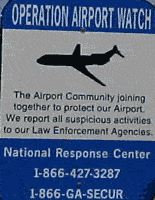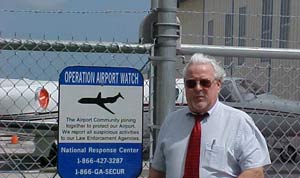
Ready for Takeoff
Florida airport installs RFID security and access control system
- By Debbie Bolles
- Apr 08, 2008
 When hurricanes in 2005 leveled the Charlotte County Airport in Punta Gorda, Fla., airport officials chose to rebuild, and to do so stronger and smarter. That meant making sure the airport’s security system satisfied federal and state regulations in a post-9/11 world that had to protect against potential terrorists turning airplanes into deadly bombs.
When hurricanes in 2005 leveled the Charlotte County Airport in Punta Gorda, Fla., airport officials chose to rebuild, and to do so stronger and smarter. That meant making sure the airport’s security system satisfied federal and state regulations in a post-9/11 world that had to protect against potential terrorists turning airplanes into deadly bombs.
The general aviation facility, used by freight carriers such as FedEx and United Parcel Service and home to 300 general aviation aircraft, needed to meet three goals in its redesign: satisfy access control and security requirements set by the Department of Homeland Security, Federal Aviation Administration, Transportation Security Administration and Florida Department of Transportation; monitor and track aircraft as they land and take off; and prevent theft and vandalism of aircraft and other airport assets.
At a cost of $300,000, the airport installed a security and access control system comprised of active RFID tags and readers, gates and intercoms operating off a wireless Ethernet network. The six-month project was finished in early 2007. Today, Punta Gorda is one of the few general aviation airports in the nation using a sophisticated active RFID access control system in advance of stringent federal security regulations for noncommercial airports.
Risky Business
"Before, the airport was wide open," said Bob Odom, COO of AFAB International, the Pompano Beach, Fla.-based security equipment and systems provider for the project. "You could drive out to the airport and park and walk out onto the runway and walk around the aircraft."
The FAA required logging in every plane that landed and took off. Most general aviation airports met this mandate through video surveillance systems. New rules that heightened protection of runways after 9/11 required stricter access control between the active airport and adjacent hangars. Punta Gorda had used a system of manual gates and on-site airport personnel, a costly and time-consuming practice that was far from reliable or even safe.
To track planes landing and taking off, the airport had previously videotaped all the runways 24 hours a day, then staff would review hours of video to transcribe each aircraft’s identification number. Because identification numbers on night flights were difficult to read, the system was error-prone, with staff oftentimes unable to identify aircraft.
In the reconstruction, the airport installed an access control system using active RFID tags and readers from Vuance of Rockville, Md. New electronic gates equipped with RFID readers for aircraft entry and exit to hangars and for employee entry and exit were built.
Each plane that uses the airport as its home base is now equipped with an active RFID tag in its windshield. When the aircraft approaches an exit to hangars, the active tag is read by the RFID gate reader, allowing the gate to open if the aircraft’s tag is interpreted as an authorized aircraft.
"We can read these tags at 2,000 feet and 200 mph," Odom said. All of the aircraft that are based there have the tag, so the airport no longer has to log in those planes since it’s done automatically. They like RFID because it gives them a range that no other system will do."
Airport employees also were given RFID tags in the form of ID badges, with three different levels of airport area access. Now, when an employee drives up to an airport entry, the tag is read by an RFID reader and the gate opens. The badge of each person in the vehicle is read, keeping track of who enters and exits the airport facility and at what time.
Fuel trucks and other airport assets also were assigned RFID tags for airport entry and exit. In all, the airport received 1,500 active RFID tags, of which more than 300 went on aircraft.
The Right Frequency
As opposed to the passive RFID tag system used in retailing, Vuance active RFID tags transmit signals to the RFID reader. Vuance T200 tags were issued to employees, and T800 tags for aircraft. The seven RFID gate readers used are R500WP Wiegand 26- or 32-bit format. Other components of the system include Insignia IP control panels and AAID software, both from Vuance.
"Ninety-nine percent of all RFID readers are active readers, meaning they make noise," said Pete Martin, president of AAID Security Solutions, a division of Vuance. "It’s considered a radio station by the FCC and those readers are heavily regulated into short range."
But Vuance passive readers don’t make that noise, since the transmission is in the tag itself. Therefore, the active tag and passive reader system permits longer-range RFID tag reading capability, providing an added benefit to transportation facilities such as airports.
Martin estimated less than 1 percent of the nation’s 19,000 general aviation airports currently use some type of RFID access and "very few of them have any security at all." All that may change, however, with upcoming TSA rules to enhance security at noncommercial airports.
Wave of the Future
Punta Gorda may be a trend-setter in terms of security technology used, but the airport opted for the advanced system in part to meet the stricter requirements of commercial airports. The Florida airport is working to regain its status as a commercial airport.
"It’s becoming more and more popular," Odom said of RFID technology used for airport security and access control. "General aviation airports haven’t been forced to do the security of commercial aviation airports … but there is a date coming up when all airports, regardless of whether they are general aviation or not, will have to have certain levels of security."
Hurricanes destroyed the Punta Gorda airport, forcing the facility to start anew and adopt state-of-the-art security technology. But had that not occurred, the airport would have been vulnerable to a potentially more disastrous outcome at the hands of terrorists.